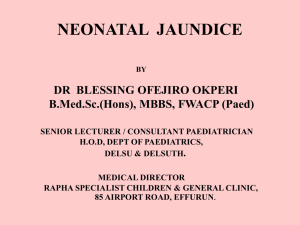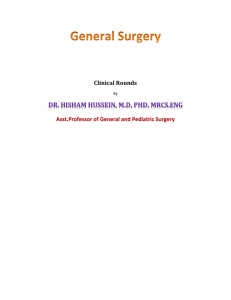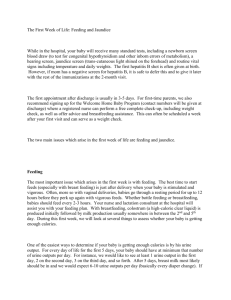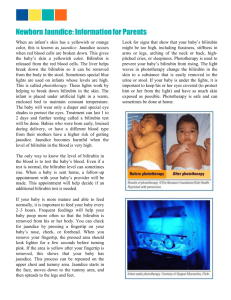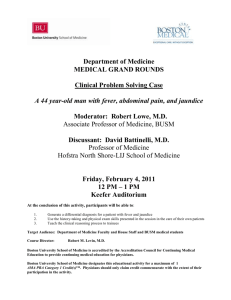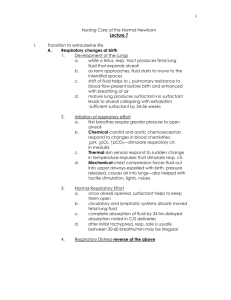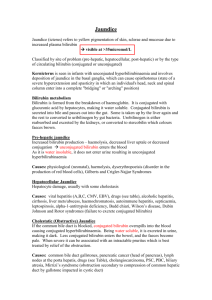Management of Jaundice in the Breastfed Infant
advertisement
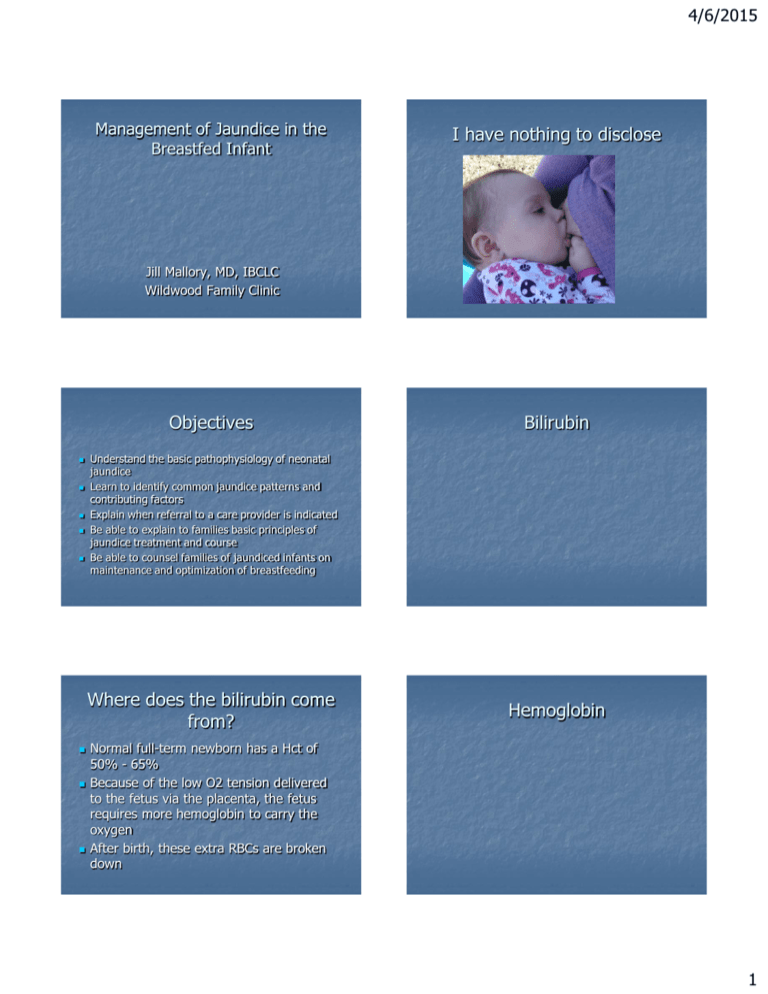
4/6/2015 Management of Jaundice in the Breastfed Infant I have nothing to disclose Jill Mallory, MD, IBCLC Wildwood Family Clinic Objectives Understand the basic pathophysiology of neonatal jaundice Learn to identify common jaundice patterns and contributing factors Explain when referral to a care provider is indicated Be able to explain to families basic principles of jaundice treatment and course Be able to counsel families of jaundiced infants on maintenance and optimization of breastfeeding Where does the bilirubin come from? Bilirubin Hemoglobin Normal full-term newborn has a Hct of 50% - 65% Because of the low O2 tension delivered to the fetus via the placenta, the fetus requires more hemoglobin to carry the oxygen After birth, these extra RBCs are broken down 1 4/6/2015 Pathophysiology Bilirubin Cycle Bone Marrow RBCs 80% Heme Catabolism Risk Factors Bilirubin non-erythroid Unconjugated bilirubinenzymes 20% Albumin (Indirect bilirubin) Liver Renal excretion Excretion Conjugated Urobilirubin bilirubin into Bile (Direct Enterohepatic Bilirubin) circulation of Bacterial conversion urobilinogen to Urobilinogen Stercobilin in Feces Blood type ABO or Rh incompatibility Drugs: diazepam (Valium), oxytocin (Pitocin) Ethnicity: Asian, Native American Maternal illness: gestational diabetes Birth trauma: cephalohematoma, instrumented delivery Excessive weight loss due to infrequent feedings Infections: TORCH Male gender Prematurity Previous sibling with hyperbilirubinemia Differential Diagnosis Bilirubin Checks Order: Unconjugated (Indirect) Conjugated (Direct) If you’re really worried: Physiologic Pathologic (ABO, sepsis) Pathologic (Biliary atresia) Why all the fuss? Bilirubin is a cell toxin Too much in the bloodstream will be deposited in various tissues of the body, including brain tissue, causing cell death Destroyed brain cells do no regenerate Too much brain damage = kernicterus Total Bilirubin = Direct + Indirect Direct Bilirubin Consider a CBC Consider a Coombs Test/DAT (Direct agglutination test) CMP Kernicterus Progressive lethargy Rigidity High-pitched cry Opisthotonos: rigid body w/ arched back Fever Seizures 50% mortality rate 2 4/6/2015 Kernicterus Kernicterus Survivors Choreoathetoid cerebral palsy Asymmetric spasticity Paresis of upward gaze High frequency deafness Mental retardation Kernicterus Bilirubin Encephalopathy Feb 2006 Pediatrics “TSB (total serum bilirubin) is, at best, a poor risk indicator for kernicterus and, at worst, an excuse for not intervening when intervention is necessary” There’s a lot we don’t know Bilirubin Encephalopathy When bilirubin is bound to albumin (indirect), it cannot cross the blood-brain barrier Lab and clinical data are consistently showing that direct bilirubin, not total serum bilirubin, is a better predictor of neurotoxicity Where do babies get albumin from? Albumin comes from good nutrition and adequate intake of milk Wennberg, R.P. et al. Pediatrics 2006; 117: 474-485 3 4/6/2015 Root Causes of Identified Cases of Kernicterus Early discharge (<48 hours) with no early follow-up (within 48 hours of discharge). This problem is particularly important in near-term infants (3537 weeks' gestation). DOL #3 home visit so important Parental teaching so important Failure to check the bilirubin level in an infant noted to be jaundiced in the first 24 hours. Failure to recognize the presence of risk factors for hyperbilirubinemia. Neonatal Jaundice and Kernicterus. PEDIATRICS Vol. 108 No. 3 Sept 2001, pp. 763-765 Root Causes of Identified Cases of Kernicterus Underestimating the severity of jaundice by clinical (ie, visual) assessment. Lack of concern regarding the presence of jaundice. Delay in measuring serum bilirubin level despite marked jaundice or in initiating phototherapy in the presence of elevated bilirubin levels. Failure to respond to parental concern regarding jaundice, poor feeding, or lethargy. Neonatal Jaundice and Kernicterus. PEDIATRICS Vol. 108 No. 3 Sept 2001, pp. 763-765 What is the typical jaundice scenario? 95% of the time Normal physiologic jaundice Normal Physiologic Jaundice 95% of the jaundice you will see Usually just face and chest Usually occurs in first week of life Begins on 2nd day, peaks on 3rd or 4th day, then disappears Kramer’s Rule 1. 2. 3. 4. 5. Face: 4-6 mg/dl Chest, upper abd: 8-10 mg/dl Lower abd, upper thighs: 12-14 mg/dl Arms, lower legs: 15-18 mg/dl Palms, soles: 15-20 mg/dl For jaundice persisting beyond the 4th day of life, refer to a care provider Normal Physiologic Jaundice Occurs in both formula and breastfed infants at equal rates Caused by: Increased amount of bilirubin produced Immature liver Refer to a care provider for >/= zone 2 4 4/6/2015 Dehydration Normal Physiologic Jaundice Bili >15 Dehydration is going to make it worse Problems with breastfeeding Delayed lactogenesis II Infrequent formula feeding Refer to a care provider if you see a baby who is dehydrated Normal Physiologic Jaundice Reabsorption of extravascular blood May serve an evolutionary purpose severe caput or cephalohematoma can make it worse Once milk is in and the baby is making the yellow seedy poops (at least 4 in 24 hrs), you’re usually in the clear Prevent Exaggeration Normal Physiologic Jaundice “Breast non-feeding Jaundice” Prevent a delay in lactogenesis II BF initiated within 1 hour of birth Rooming-in, Lying-in Feed according to baby’s cues (10/24hrs) In other words . . . The old term “breastmilk jaundice” is actually hospital-caused jaundice Or Non-baby friendly jaundice When these three things are done, formula fed and breastfed infants have equal incidence of exaggerated physiologic jaundice (Gartner and Herschel 2001) 5 4/6/2015 What is the ONLY reason to ever interrupt breastfeeding in the jaundiced baby? What is the ONLY reason to ever interrupt breastfeeding in the jaundiced baby? Galactosemia Other Causes Gastrointestinal Problems Increased enterohepatic circulation secondary due to intestinal obstruction Gastrointestinal Problems Bilirubin metabolism problems Crigler-Najjar syndrome Gilbert syndrome Hypothyroidism Hypoxia Lucey-Driscoll syndrome Cystic fibrosis Hirschsprung disease Ileal atresia Pyloric stenosis Other causes of intestinal obstruction Hematological Problems ABO incompability Rh incompatability Clotting disorders Autoimmune disease Hemoglobinopathies Microangiopathies Red cell enzyme defects - Glucose-6-phosphate deficiency, pyruvate kinase deficiency Red cell membrane defects - spherocytosis, elliptocytosis 6 4/6/2015 G6PD Miscellaneous Acidosis Dehydration Hypoalbuminemia Infant of a diabetic mother Medication Sepsis Swallowed maternal blood Gilbert’s Syndrome Also known as constitutional hepatic dysfunction and familial non-hemolytic jaundice. Inherited gene mutation 5% of the population Reduced activity of the enzyme glucuronyltransferase, which conjugates bilirubin Biliary Atresia Isoimmune Hemolytic Disease Maternal antibodies attack RBCs in the newborn Leads to hemolysis Causes jaundice and anemia Mom blood type O & baby blood type A, B or AB Rh or Kell antibody Positive direct coombs test in baby Biliary Atresia Biliary atresia: abnormal bile ducts inside or outside the liver Bile ducts Widespread and frequently unrecognized Mediterranean and in the Middle East, Arabian peninsula, Southeast Asia, and Africa. Occurs in 11% to 13% of African Americans, and kernicterus has occurred in some of these infants G6PD level should be checked in any jaundice infant requiring lights with an ethnic risk remove waste from the liver carry salts that help the small intestine digest fat Bile flow from the liver to the gallbladder is blocked. Leads to liver damage and cirrhosis of the liver 7 4/6/2015 Prevention Educated pregnant women on the importance of: Early initiation of breastfeeding Prevention In the first hour after birth Skin-to-skin How to establish a milk supply Rooming-in Management of Jaundice Exclusive breastfeeding should be encouraged Feeding anything prior to the onset of breastfeeding: delays the establishment of good breastfeeding practices by the infant delays establishment of adequate milk production increases the risk of starvation and exaggerated physiologic jaundice. Bhutani Curve AAP 2004 8 4/6/2015 Johnson Nomogram Management of Jaundice Optimize breastfeeding Assess latch and position Educate on early feeding cues Assess stool and urine output Assess frequency of feeds Watch a feeding AC/PC weights Management of Jaundice Identify at risk dyads Pay especially close attention to latepreterm babies Management of Jaundice Supplementation with expressed breastmilk, banked human milk, or formula (in that order of preference) should be limited to infants with at least one of the following: A clear indication of inadequate intake: weight loss in excess of 10% after attempts to correct breastfeeding problem. Failure in milk production or transfer adjusted for duration of breastfeeding and documented by preand post feeding weights after attempts to increase milk production and milk transfer. 34 weeks, and 36 weeks and 6 days “Imposters” Greater risk of feeding difficulties Less mature liver Lower threshold to start supplementation Management of Jaundice Supplementation with expressed breastmilk, banked human milk, or formula (in that order of preference) should be limited to infants with at least one of the following: Evidence of dehydration defined by: Significant alterations in serum electrolytes, especially hypernatremia, and=or clinical evidence of significant dehydration (poor skin turgor, sunken fontanelle, dry mouth, etc.). 9 4/6/2015 Management of Jaundice If a supplement is needed Management of Jaundice If you are working with a provider who interrupts breastfeeding Management of Jaundice Make sure you provide education to the mother on maintaining her supply Low-supply with breastfeeding resumes may cause bili levels to rise again Encouragement to continue breastfeeding is of the greatest importance Management of Jaundice Phototherapy Bili-blanket Overhead lights Home vs hospital Interruption for durations of up to 30 minutes to permit breastfeeding without eye patches does not alter the effectiveness of the treatment. Maisels MJ, Bhutani VK, Bogen D, et al. Hyperbilirubinemia in the newborn infant>or¼35 weeks’ gestation: an update with clarifications. Pediatrics 2009;124:1193–1198. Management of Jaundice Exchange transfusion Tips for Mothers Second-line treatment IVIG in infants with Rh or ABO isoimmunization can significantly reduce the need for exchange transfusions. Nurse your baby as much as possible, ideally at least 812 times daily(breastmilk helps eliminate bilirubin since it helps them have more frequent stools) Know your baby’s feeding cues, so you don’t miss an opportunity for a feeding Make sure your baby has a proper latch and gets a full feeding at each nursing session Do not supplement with anything without talking to your care provider or lactation consultant first 10 4/6/2015 Tips for Mothers Watch for signs of dehydration Case Study Dry mouth, No tears, Red brick-dust urine Inadequate stools Remember that nothing about your breastmilk is bad for baby Trust your Mommy instinct, but if things worsen don’t hesitate to speak to a lactation consultant and your doctor Prenatal History 27yo single mother Unintended, but welcome pregnancy G2P1 w/ dates by 1st trimester US Quad screen was abnormal, but amniocentesis was normal A + blood type GBS negative Prenatal History Birth History NSVD at 36 wks 7.5 hr labor without augmentation Apgars 9 and 9 Birth weight 5lbs 10oz (2550g) Healthy baby Mother chronically depressed Also caring for 3yo daughter Works as CNA No help from baby’s father Grandmother of baby supportive Regular prenatal care Plans to breastfed, because sister did Caucasian mother, African-Am. father Postpartum Baby removed from mom right after birth per her preference for routine cares Nursing gives formula b/c baby is “small” Nursing comments mom is sleeping a lot and leaving baby in bassinette PPD #1 Good latch and suck observed 11 4/6/2015 Discharged Home Visit to WIC Office Tuesday Day of life 2 Friday afternoon Good pees and poops from baby Rounding MD notes normal exam Nursing notes mention slight jaundice Bili was not checked Discharge weight 5 lbs 7 oz Mother states that son "Looks kind of red." Born at 36 weeks. Eating, pooping, peeing well. Eating every couple hours. She just noticed redness today. Seems like it is all over. No fever. Did not notice any yellow eyes. No behavioral changes. <5% loss from birth weight WIC Office Visit Day of life 6 Mom’s milk is in Weight 5lbs 6oz (5% loss) Mom seems a little overwhelmed Endorses breastfeeding every 2-3 hrs, but sleeping through the night WIC Office Visit Mild scleral icterus and jaundice to abd noted Alert with normal tone Urine has been clear to light yellow Very worried b/c brother of mom died in infancy due to a “liver problem and had jaundice” What would you advise? 1. 2. 3. 4. Go to ER right away Call to MD’s office Phone call to check in again in am Hey, don’t worry, red is in! Results STAT Total Bili is 24 mg/dl (H) Reminder: Direct bili is also 0.4 mg/dl (H) Indirect = unconjugated Has not yet passed through the liver Bound in the blood to albumin Direct = conjugated Bound in the liver to glucuronic acid 12 4/6/2015 What would expect for treatment? 1. 2. 3. 4. Bhutani Curve Home bili blanket with close follow-up Admission back to hospital for lights Re-check in 2 days Re-draw the bili. This must be an error. What do you want to know? Bili level and age in hours at draw Where on the curve Percent weight loss How is feeding going? Hydration status Any known risk factors? Is baby alert and vigorous? Your exam Admit to Hospital Admit to Hospital Placed under bili lights in NICU Next am bili 13.5 mg/dl Noon re-check bili 13.0 mg/dl W/u negative for cause Pt discharged 6pm with home bili blanket on DOL #7 F/u next day with MD On admission Indirect bili 16.4 mg/dl (H) Direct 0.5 mg/dl Potassium a little elevated Lytes otherwise normal CBC w/diff normal Newborn screen normal Day of life 8 Weight 5 lbs 11oz (1 oz over birth wt) Afebrile Normal exam Some persistent jaundice Bili re-check 14.2 mg/dl Told to discontinue bili blanket Re-check in 24 hrs 13 4/6/2015 Johnson Nomogram How do we figure out when to stop or start the lights? Johnson Nomogram Day of life 9 Bili re-check 12.8 mg/dl Good pees and poops Acting normal Bili blanket stopped Plan to re-check in 24 hrs Day of Life 10 Indirect Bili 14.9 mg/dl Good pees and poops Acting normal Re-check in 24 hrs Day of life 11 Full WCC with MD Mild jaundice noted Otherwise normal exam Good weight gain Bili re-check 13.8 mg/dl Re-check in 2 days 14 4/6/2015 Days of Life 16-18 Clinic Bili check DOL 16: 14.5 mg/dl Slightly up from last check Results called to mom who is very frustrated and fearful Mom visits a couple of different ERs and urgent cares with concerns about baby looking jaundice Bili’s all around 13 to 14 Day of Life 19 Clinic visit Mom worried about worsening jaundice Large weight gain Afebrile Normal behavior Exclusively breastfed Total bili 18 mg/dl Direct bili 0 Johnson Nomogram What is the diagnosis? G6PD (glucose-6-phosphate dehydrogenase ) deficiency Gilbert’s Syndrome Isoimmune hemolytic disease Biliary atresia Hypothyroidism Intestinal obstruction Exagerated physiologic jaundice secondary to Sepsis Dehydration Gestation < 38 weeks Answer Prolonged unconjugated hyperbilirubinemia Let’s think back through our differential again . . . His indirect is elevated = unconjugated Prolonged jaundice is defined as >14 days in term infants >21 days in preterm infants 15 4/6/2015 Differential Diagnosis Unconjugated Hyperbilirubinemia What is the reason for his Unconjugated Hyperbilirubinemia? His uncle’s mystery liver disease Gilbert’s Syndrome Some sinister component in breastmilk Dehydration Physiologic jaundice G6PD Hemolytic disease Biliary atresia 1. 2. 3. 4. 5. 6. 7. 8. What Was Done. . . MD wasn’t sure . . . jaundiced uncle thing? Pediatrician suggested to mom a 24 hr “trial” off breastmilk If dramatic bili drop occurs -> dx “breastmilk” jaundice -> baby must stop breastfeeding Recommended Peds GI consult Breastfeeding Interrupted Mom not able to pump due to stress Baby gets formula for 43 hrs Mom’s supply drops Bili re-check = 17.4 mg/dl (down from 18mg/dl) Baby vomits formula and develops respiratory congestion & constipation Day of Life 21 Mom still wants to nurse. Worried about supply. Seeks out Dr. Mallory for lactation consult. Dr. Mallory steps in at this point and tells mom to put baby back to breast. Sent to St. Mary’s for Labs: CBC Hepatic function panel Seen in ER Brief respiratory illness clears after 4-5 days AST, ALT, albumin, GGT, alk phos G6PD level Coombs test All normal Indirect Bili is now 17.2 mg/dl (17.4 mg/dl) 16 4/6/2015 Graph of Bili by Day of Life Mom and pediatrician are still scared about the dead uncle . . . 30 25 20 Indirect Bilirubin (mg/dl) 15 10 5 0 0 10 20 30 Peds GI Consult for Prolonged Jaundice Peds GI call this “breastmilk jaundice” Stop breastfeeding and re-check bili every 2-3 days Mom has stopped breastfeeding Day of Life 24 Day of Life 39 Indirect Bili 8.9 Indirect Bili 6.4 Consequences Day of life 45 Hospitalized with RSV Breastfed infants have fewer RSV infections, and when they do get sick with RSV, they have less severe cases and fewer hospitalizations. Holberg,C.J., "Risk Factors for RSV Associated lower Respiratory Illnesses in the First Year of Life". AM J Epidemiol 1991; 133 (135-51). 17 4/6/2015 What could have been done better? Baby taken away from mother right after birth Mother without adequate postpartum help Sufficient breastfeeding counseling and expectations Bili should have been drawn prior to hospital discharge What could have been done better? Friday discharge baby should have been seen in follow-up Saturday or Sunday Evidence supports universal screening (Johnson and Bhutani 1998) How should this baby have been managed? In infants with prolonged unconjugated hyperbilirubinemia If no evidence of sinister cause: If bili 12-17 mg/dl, support breastfeeding Take Home Messages Feed 10-12/24 hrs Evaluate latch Monitor poops and pees Continue to monitor bilirubin levels every 12-24 hrs If bili 17-25 mg/dl Once level <15 mg/dl, stop checking Initiate phototherapy until <17 mg/dl Let mom and baby initiate feeding and bonding before all of your routines Check bili in any baby with jaundice and <24 hrs old Follow-up the breastfed infant on day 3 to make sure milk is in and stools are transitioning Am Acad of Peds Subcommittee on Hyperbili Pediatrics 2004; Gartner Pediatr Clinics of N. Am. 2001; Grunebaum Eur J Pediatr 1991; Johnson and Bhutani Journal of Pediatrics 2002; Maisels Pediatrics 1995; Schneider Jama 1986; Yamauchi Pediatrics 1990 Take Home Messages Give mom breastfeeding education and expectations prenatally Night feeds are needed Encourage postpartum support plan Don’t blame the breastmilk No benefit to “trial off breastmilk” No role for supplementation unless low supply, dehydrated baby etc. Home visits!!!!! Babies should have a weight check within 1-2 days after hospital discharge to prevent exaggerated jaundice (AAP Subcommittee on Neonatal Hyperbilirubinemia 2001) Especially given risk factor of 36 week gestation Have parents monitor urines and stools Check weight and skin tone Observe latch Take Home Messages Use your Bhutani curve to know when the level needs to be re-checked Use lights when intervention needed according to the Johnson curve MD involved at this point Ensure adequate hydration and breastfeeding Get a lactation specialist involved if any problems out of your comfort zone 18 4/6/2015 Take Home Messages The End If you’ve ruled our sinister causes, prolonged unconjugated hyperbilirubinemia will resolve on its own Probably Gilbert’s Give it time and follow closely until bili <15 19
